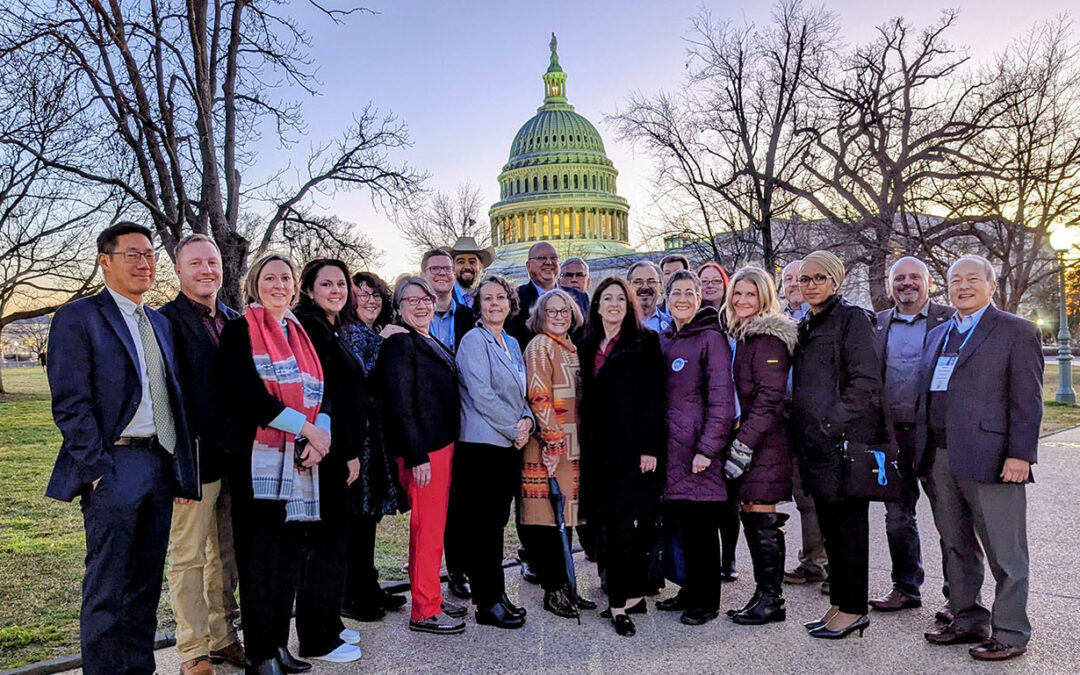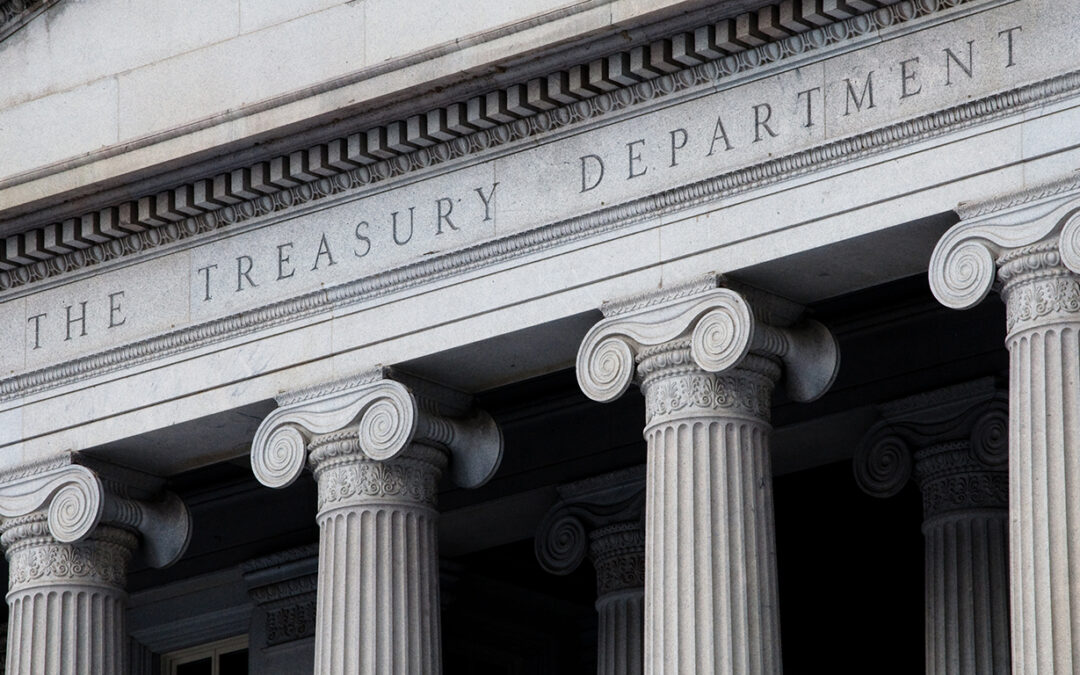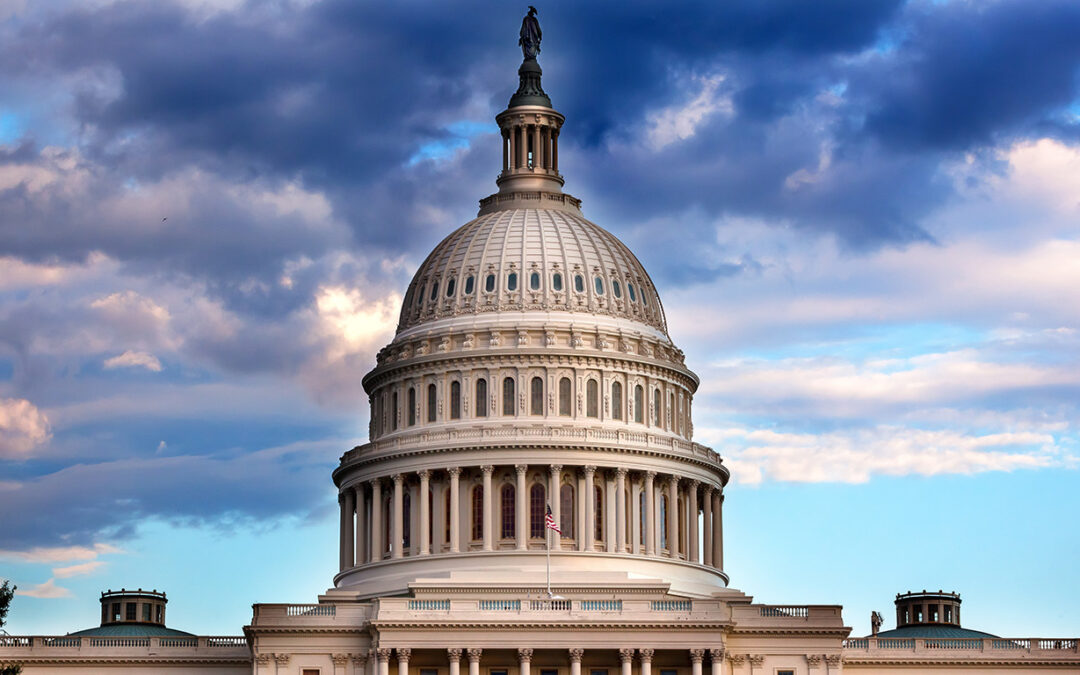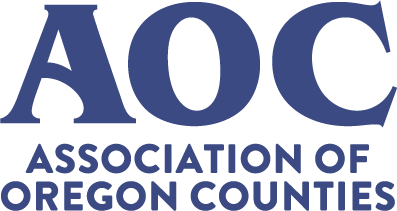
Feb 28, 2023 | NACo
Thirty-seven Oregon county commissioners, judges, chairs, and staff traveled to Washington, D.C. to participate in the 2023 National Association of Counties (NACo) Legislative Conference, held February 11-14.
County officials also met with Oregon Senators Ron Wyden and Jeff Merkley to advocate for Association of Oregon Counties (AOC) federal policy priorities.
First-time attendee, Polk County Commissioner Jeremy Gordon commented, “It was powerful to join my AOC colleagues to speak with Senators Wyden and Merkley with one voice around our shared needs for behavioral health crisis services, housing, flexible transportation funding, and sustained SRS funding.”
During the conference, the Oregon delegation engaged in NACo policy discussions through NACo’s policy steering committee process, as well as breakout sessions, and general sessions, hearing from a range of speakers in the federal government, including President Joe Biden, U.S. Secretary of the Treasury Janet Yellen, U.S. Transportation Secretary Pete Buttigieg; U.S. Secretary of Agriculture Tom Vilsack, U.S. Department of Health and Human Services Secretary Xavier Becerra, and administration staff.
“Learning the ways we can leverage this time of historic investment to help our communities is motivating. Figuring out how to navigate the federal funding streams provides an abundance of opportunities,” said Klamath County Commissioner Kelley Minty of the programming and resources provided during the conference.
The conference offers not only policy discussions, but a platform for connecting with commissioners across the United States. “I was able to learn about commonalities and the innovative ways federal programs are implemented in other communities, and through the Human Services and Education Steering Committee, I was able to give voice to the mental health struggles Polk County youth and adults are experiencing and ways we can better align the intentions of federal programs with my community’s needs,” said Gordon.
AOC Executive Director Gina Firman Nikkel added, “The conference is a key point for our commissioners to network together, get to know each other, build trust, and meet commissioners from other counties to work on key issues that are important to them.”
NACo steering committees tackled a number of issues relevant for counties across the U.S. and took positions on policies that would inform NACo’s work among federal agencies, Congress, and the White House on issues ranging from wildfire, to health care, to broadband, among others.
The work addressed in the steering committees unite counties across the United States in their advocacy efforts at the national level. Tillamook County Commissioner David Yamamoto agreed, “The issues that we face in individual counties across Oregon and all across Oregon are the same issues that you find across the nation.”
Notably, during the final day of the conference, NACo announced the appointment of AOC Executive Director Gina Firman Nikkel, Ph.D. to the newly created NACo Mental Health and Wellbeing Commission. The commission will work to drive change in the nation’s mental health system and policies.
“Participating in NACo is one of the best things you can do not only for your professional development, but you bring new and innovative ideas back to your county,” said Clackamas County Commissioner Martha Schrader, who chairs the NACo Community, Economic, and Workforce Development Steering Committee. She urged county officials to engage in their national association.
County officials across Oregon found meaning in the program content, as well as the networking opportunities. “The great thing about NACo is the comradery,” said Yamamoto.
Proposed NACo Interim Policy Resolutions can be found here.
AOC federal priorities can be found here.
Contributed by: Megan Chuinard | Public Affairs Associate

Feb 27, 2023 | NACo
On Feb. 21, the U.S. Department of the Treasury (Treasury) resumed operations of its Office of Recovery Programs Contact Center which provides technical assistance to recipients of American Rescue Plan Act (ARPA) funds administered by Treasury. This includes the State and Local Fiscal Recovery Fund (Recovery Fund), the Local Assistance and Tribal Consistency Fund (LATCF), and the Emergency Rental Assistance (ERA) program. Treasury alerted county recipients to the Contact Center’s reopening on Feb. 14, stating that:
“The Contact Center closed last year due to an administrative funding shortfall, which impacted Treasury’s ability to provide support to recipients of funding from the Office of Recovery Programs. However, late last year Congress provided additional resources for the Office of Recovery Programs in the Consolidated Appropriations Act, 2023. As a result, Treasury is able to reopen the Contact Center in order to better support recipients by answering their phone and email inquiries.”
Since the bill’s initial introduction in Oct. 2021, the National Association of Counties (NACo) has advocated for the passage of the State, Local, Tribal, and Territorial Fiscal Recovery, Infrastructure, and Disaster Relief Flexibility Act to provide counties with the flexibility to invest funds in transportation infrastructure, Community Development Block Grant (CDBG)-eligible and natural disaster related projects. The bill was ultimately passed as an amendment to the Fiscal Year 2023 omnibus appropriations bill (Consolidated Appropriation Act of 2023) in Dec. 2022. In addition to the expanded flexibilities, the bill also unlocked unobligated administrative funds for the Office of Recovery Programs that has allowed Treasury to reopen this contact center. Treasury is expected to release additional guidance for the bill’s expanded eligible uses in the coming month. NACo will alert counties when this guidance is available.
Since ARPA was enacted in March 2021, counties have been working tirelessly with Treasury to ensure Recovery Funds have the flexibility to properly address our unique needs and that we are fulfilling our role as sound financial stewards. Treasury has been a critical partner and valuable resource throughout the implementation of the Recovery Fund and with the recent release of LATCF payments, this partnership is as critical as ever.
NACo also has several resources available to counties to assist with the continued implementation and investment of the Recovery Fund and LATCF. Counties may ask questions regarding ARPA recovery funds here and NACo staff will respond via email.
Contributed by: Maxx Silvan | NACo

Jan 20, 2023 | NACo
On December 23, 2022, the U.S. Congress enacted a Fiscal Year (FY) 2023 omnibus appropriations bill to fund the federal government through September 30, 2023. Enactment of the omnibus followed a series of Continuing Resolutions (CR) to fund the federal government and avert a government shutdown since the beginning of the federal fiscal year on October 1, 2022. President Biden signed the $1.7 trillion omnibus appropriations bill into law on December 29, 2022.
For the second year in a row, discretionary spending levels for FY 2023 were not limited by statutory spending caps prescribed by the Budget Control Act of 2011. As such, the White House, congressional leadership, and top appropriators negotiated topline spending levels over several months.
The FY 2023 omnibus includes several key investments of importance to counties detailed in this report. These include, but are not limited to, full funding for the Payments in Lieu of Taxes (PILT) program and significantly invests in the RECOMPETE pilot program and technology hubs authorized by the bipartisan CHIPS and Science Act. These programs and others funded by the bill, including a $550 million increase in wildland fire suppression, will enable counties to provide critical services and plan for economic sustainability and growth in 2023.
The final omnibus represents a total of $1.7 trillion in discretionary spending across all 12 spending bills. Of this total amount, $773 billion is in non-defense discretionary spending, an increase of 5.9 percent over the comparable FY 2022 level, and $858 billion is in defense discretionary spending, an increase of 9.7 percent.
In addition to regular programmatic funding and extensions, the FY 2023 omnibus included nearly $10 billion in earmarks (rebranded as community project funding and congressionally directed spending), representing 4,000 projects, for the first time in nearly a decade, although with increased transparency and guardrails. As a result, hundreds of county programs and critical infrastructure projects aimed to better serve communities will receive direct federal investments.
The omnibus bill delivers on many county priorities which are detailed in the National Association of Counties (NACo) report here. Notably, during consideration of the final omnibus agreement, the U.S. Senate adopted an amendment to the package offered by Sens. John Cornyn (R-Texas) and Alex Padilla (D-Calif.) the bipartisan State, Local, Tribal and Territorial Fiscal Recovery, Infrastructure and Disaster Relief Flexibility Act. This amendment grants additional flexibility to county governments in investing resources from the American Rescue Plan’s (ARPA) Coronavirus State and Local Fiscal Recovery Fund, including infrastructure, community development, and disaster response. It will also provide the U.S. Department of the Treasury with much-needed resources to assist counties in deploying recovery funds.
This analysis includes funding highlights for key programs impacting counties. Click here to view NACo’s analysis.
Click here for the original article.
Contributed by: The National Association of Counties



